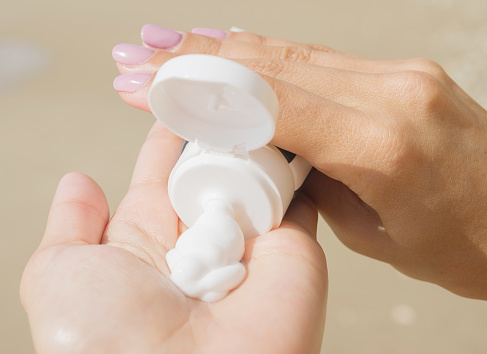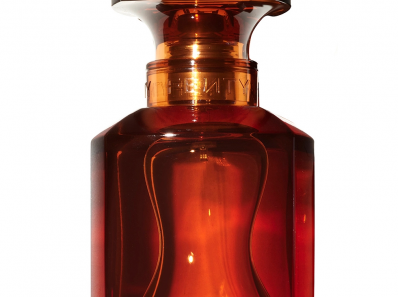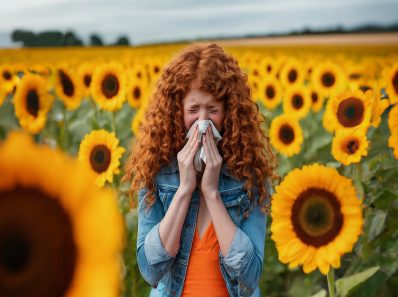A survey reveals that Brits are not as “sun savvy” as they first thought with almost half (48 per cent) admitting to burning over the last year.
The poll, by Stratumclinics.com, questioned 1,000 people about their summer skin habits and despite three-quarters of those polled (72 per cent) describing themselves as “sun savvy” when it comes to knowing how to protect their skin from the sun, almost half have still experienced sunburnt skin in the last 12 months, for one reason or another.

- One in five (20 per cent) admitted to burning during a short period outside whilst not wearing SPF.
- While 16 per cent confessed to burning because they’d not applied SPF regularly enough for adequate protection throughout the day.
- One in ten (12 per cent) experienced sunburnt skin because they skipped SPF in favour of trying to catch the sun to tan.
- Meanwhile, 16 per cent burnt because they’d skipped SPF on a cloudy day.
Our faces and shoulders were amongst the most overlooked body part with almost a third (29 per cent) forgetting to apply SPF protection to these areas and burning as a result.
Leading consultant dermatologist, Dr Adam Friedmann, warns that sun exposure is one of the biggest risk factors in the development of melanoma and that even short-term episodes of sunburn or sun exposure will increase the risk of skin cancer, even on a cloudy day.
“There is no proven way to reverse the signs of sun damage to the skin, so prevention is always key. Ultraviolet A and B (UVA and UVB) rays cause changes in the skin’s DNA leading to mutations and increasing the risk of cancer in skin cells and melanocytes – which are the pigment-producing cells that make moles,” said Dr Adam Friedmann.
“Taking measures to protect the skin and regularly checking your skin and moles for any changes is a good way to manage signs of sun damage.”
With clinics nationwide, the skin doctors at Stratum Dermatology Clinics offer mole checks, skin cancer screenings and mole removal.
ASK THE EXPERT – SKIN CANCER PREVENTION
Consultant dermatologist for Stratum Dermatology Clinics (www.stratumclinics.com), Dr Adam Friedmann, explains how and why we should be “sun savvy” this summer.
What damage does the sun do to our skin in general?
Dermatologists have long been campaigning for people to apply high SPF (sun protection factor) during the summer and SPF is the most important product in your skincare regime to prevent burning.
In addition to skin cancer risk, prolonged sun exposure can also lead to premature ageing because it breaks down collagen. Collagen is the underlying elastic support tissue that gives skin its strength, smoothness and elasticity. Sun damage over time, causes these collagen strands to shrink, become thinner and break down. This can make the skin appear wrinkled, have less elasticity, and feel dry and itchy.
UV damage can also cause the skin to develop uneven pigmentation and hyperpigmentation, commonly referred to as age spots or sunspots.
Sun exposure may also trigger melasma–mottled darkening of the skin on the face. The exact cause of melasma is not fully known but it is thought that the melanocytes in the skin, the pigment-producing cells, produce too much pigment in certain areas. This can appear anywhere on the body, but most commonly on the face, when exposed to the sun. It is commoner in women and in those with darker skin tones and who tan very quickly.
Top ten precautions for “savvy summer skin”
1. Opt for the fake tan! You cannot change your skin type and trying to tan naturally pale type 1 and 2 skin will only increase your risk of skin cancer, and not protect you because there isn’t enough melanin in the skin to go brown. When sunbathing, it is important to remember that the skin has a tanning cut-off point when it cannot produce any more melanin. When you reach this limit, you can tan no more and instead are just being damaged by the sun’s ultraviolet rays.
2. Go high and wear an SPF sun cream with at least factor 30, but ideally 50 on your face to protect from the photo ageing effects of ultraviolet B (UVB). The SPF number represents the degree of sun protection a cream provides to the skin compared with bare skin. For instance, after the SPF50 application, the skin gets the equivalent of one minute of sun exposure for every 50 minutes spent in the sun.
3. Children’s sunscreen is a great choice for adults too. It goes on well and is often great for sensitive skin and is delicate around the eyes. I like Nivea for kids for SPF50 sunscreen, Altruist sunscreen and own-brand sunscreens e.g. Boots Soltan which applies well without ghosting/whiting.
4. Look for sun creams with five stars of “UVA” protection on the label to give the highest levels of defence. While UVA rays have less energy and don’t burn the skin, they do cause the skin to age and contribute to the development of melanoma along with the burning rays, UVB.
5. Apply enough SPF. People rarely apply enough SPF, reducing protection dangerously. Continue to apply sunscreen regularly throughout the day, every two hours, to protect your skin in the sun. A typical person on a week’s holiday should use 50ml of sunscreen every day when applying enough cream on a regular basis. Set a reminder on your phone so you don’t forget and beware that if you sweat excessively or rub the skin with a towel then reapply sun cream. Up to 85 per cent of a product can be removed by towel drying.
6. Tinted moisturisers won’t protect the skin all day. Tinted moisturisers and moisturisers with SFP are great for short bursts of sun exposure but not suitable for longer stints outside. A downfall is that users tend to apply them first thing in the morning, rather than reapplying every two hours as recommended for an SPF, and it is often applied in a much thinner layer meaning it’s not providing the protection promoted on the bottle. Be aware that a facial moisturiser with SPF won’t offer sufficient protection needed to protect you throughout the day when applied once in the morning.
7. Hat and SPF combo. Don’t mistakenly think your face is fully protected by a hat. Sunlight is reflected from water, sand, glass and even snow, so a hat is of limited use to protect the face without the additional use of sunscreen. As much as half of tanning or burning of the face is caused by reflective UV rays.
8. Consider how much sunscreen you’re applying too. Apply the equivalent of half a teaspoon to the face, neck and backs of ears and over half a teaspoon to each arm. A full teaspoon to the back, the chest and each leg. Applying less will reduce the protection to a higher degree than is proportionate – for example, only applying half the required amount can actually reduce the protection by as much as two thirds.
9. UVA rays can penetrate glass too. So, if you’re sitting at a desk all day by a sunny window or driving then you need some protection. Although UVA rays don’t cause burning, they do contribute to the risk of developing skin cancer.
10. Cover up when out in the sun and seek shade in the strong midday sun. Generally, wearing cotton and linen clothing offers the same protection as SPF80. The colour doesn’t make a difference as it’s the fibre doing the work of cutting out the UV. A big plus is that its efficacy doesn’t fade throughout the day like sunscreen, which rubs off.
It’s important to be savvy on how to spot the signs of skin cancer too. Skin cancer usually presents itself as a mole or mark on the skin and can be dismissed because people don’t notice it or don’t want to bother their GP. Be on mole watch this summer and remember our motto; “a change needs a check”.
Why is it important to check moles?
It’s really important to get into the habit of doing a quick mole check each month, in front of the mirror, where you take a look at all the skin and thoroughly search for anything new or different.
The take-home message about mole checking is that if you can recognise the initial signs of changing moles and catch a melanoma early, it can be completely cured. But if you miss the signs and get it late, then you have a much higher chance of it spreading and becoming fatal.
For those who don’t feel confident checking their own moles or simply forget to do so, then a mole mapping service offered at Stratum Dermatology Clinics offers a safeguard by using skin-imaging technology to catch suspicious moles before they evolve into skin cancer.
Visit stratumclinics.com to find your closest clinic situated across the UK.



